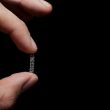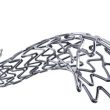Courtesy of Dr. Carlos Fava. Nowadays, chronic total occlusions (CTO) due to in-stent restenosis (ISR) represent 5%-25% of all coronary angioplasties. These lesions pose a new and true challenge, since CTOs are often associated with stent-related problems (fractures, lack of expansion, overlapping, deformation), extreme tortuosity, severe calcification, tandem lesions after CTO, and aorto-ostial lesions, with little<a href="https://solaci.org/en/2017/06/26/success-in-ctos-caused-by-restenosis-lowers-cardiac-mortality/" title="Read more" >...</a>
The use of IVUS in unprotected left main PCI associated to better outcomes, compared to angiography guided PCI
Courtesy of Dr. Gustavo Leiva. Coronary Artery Bypass Graft (CABG) has traditionally been the procedure of choice in patients with left main coronary artery disease. However, the use of percutaneous techniques in this kind of lesions has been on the rise, partly due to recent research showing similar outcomes with both procedures. Unprotected left main<a href="https://solaci.org/en/2017/06/26/the-use-of-ivus-in-unprotected-left-main-pci-associated-to-better-outcomes-compared-to-angiography-guided-pci/" title="Read more" >...</a>
Successful angioplasty in elderly patients with chronic total occlusion reduces mortality
Courtesy of Dr. Carlos Fava. Nowadays, the number of coronary angioplasties carried out on patients with chronic total occlusion (CTO) is increasing due to many studies showing that it improves ventricular function, reduces symptoms, and improves survival. However, most of these works do not include patients of over 75 years old due to their frailty and<a href="https://solaci.org/en/2017/06/19/successful-angioplasty-in-elderly-patients-with-chronic-total-occlusion-reduces-mortality/" title="Read more" >...</a>
Everolimus DES are more effective and less costly than conventional BMS
Courtesy of Dr. Guillermo Migliaro. Drug eluting stents (DES) represented the greatest technological advance in the treatment of instent restenosis from conventional metallic stents (BMS), especially cobalt chromium everolimus eluting stents (CoCr EES), which have shown an excellent profile, and are mostly safer, compared to first generation DES. Indeed, several randomized studies and meta-analyzis have<a href="https://solaci.org/en/2017/06/16/everolimus-des-are-more-effective-and-less-costly-than-conventional-bms/" title="Read more" >...</a>
Mortality at one year in post PCI myocardial infarction
Courtesy of Dr. Brian Nazareth Donato. Multiple definitions with biomarkers and variable thresholds have been proposed to diagnose post procedural MI. The last update of the Third Universal Definition of Myocardial Infarction decided to use only troponin values with a threshold >5 over the normal value, on top of the clinical evidence by ECG, echocardiography<a href="https://solaci.org/en/2017/06/11/mortality-at-one-year-in-post-pci-myocardial-infarction/" title="Read more" >...</a>
EuroCTO: Rechanneling vs. Optimal Medical Treatment in Total Occlusions
Courtesy of the SBHCI. Chronic total occlusions represent around 18% of all coronary lesions. However, they account for just 5% of all interventions, which means that many patients only receive medical treatment. This prospective, open, multicenter study randomized patients with multivessel lesions in whom at least one of these was a chronic total occlusion. Patients<a href="https://solaci.org/en/2017/06/02/eurocto-rechanneling-vs-optimal-medical-treatment-in-total-occlusions/" title="Read more" >...</a>
AIDA: bioresorbable scaffold thrombosis still a concern in studies
Courtesy of the SBHCI. This study presented at PCR and simultaneously published by NEJM still challenges the safety of bioresorbable scaffolds. This was a multicenter noninferiority work carried out in the Netherlands, comparing 1:1 everolimus-eluting bioresorbable scaffold ABSORB and permanent-polymer everolimus-eluting stent Xience. The primary endpoint was target-vessel failure (a composite of cardiac<a href="https://solaci.org/en/2017/06/02/aida-bioresorbable-scaffold-thrombosis-still-a-concern-in-studies/" title="Read more" >...</a>
PRISON IV: DES with resorbable polymer vs. DES with permanent polymer in total occlusions
Courtesy of SBHCI. The PRISON IV trial compared the sirolimus eluting stent with ultra-thin struts and biodegradable polymer vs. the second-generation everolimus-eluting stent with thin struts and durable polymer in successfully recanalized chronic total occlusions. This is a sub-study with optical coherence tomography (OCT). The study included 330 patients, 85% angiographically followed up at<a href="https://solaci.org/en/2017/05/30/prison-iv-des-with-resorbable-polymer-vs-des-with-permanent-polymer-in-total-occlusions/" title="Read more" >...</a>
Leaders Free ACS: Good Results for the Polymer-Free Stent at 2 Years in ACS
Courtesy of the SBHCI. Guidelines recommend dual antiplatelet therapy for a year in patients admitted with coronary acute syndrome. However, patients at high risk for bleeding who receive coronary angioplasty have been historically excluded from studies. The new polymer-free stent BioFreedom allows for the reduction of dual antiplatelet therapy time, due to rapid drug elution<a href="https://solaci.org/en/2017/05/30/leaders-free-acs-good-results-for-the-polymer-free-stent-at-2-years-in-acs/" title="Read more" >...</a>
EVOLVE II: Diabetes Substudy: Results at 3 Years after the SYNERGY Stent in Diabetics
Courtesy of SBHCI Diabetic patients have worse evolution after coronary PCI. Drug eluting stents with bioresorbable polymers were designed to facilitate arterial healing, and reduce inflammation and late and very late thrombosis risk. This sub-study of diabetic EVOLVE II patients presents the 3 year outcomes of the SYNERGY stent. The EVOLVE II included<a href="https://solaci.org/en/2017/05/25/evolve-ii-diabetes-substudy-results-at-3-years-after-the-synergy-stent-in-diabetics/" title="Read more" >...</a>









